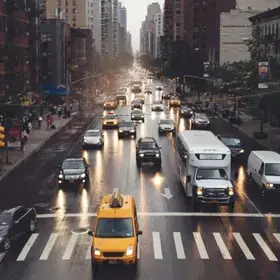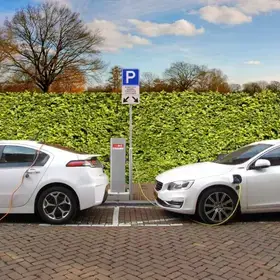By Dr. Steven Cohen, Senior Vice Dean, School of Professional Studies; Professor in the Practice of Public Affairs, School of International and Public Affairs
While it took the Civil War and Abraham Lincoln’s dream of an American middle class to get the federal government into building infrastructure, our government has been investing in infrastructure and stimulating the economy since the 19th century. The idea of a free market unsubsidized by government has always been a myth. States like New York got started earlier than the federal government when they built the Erie Canal. The canal opened in 1825 and was so successful that its tolls paid back the debt for its construction in about a year. By connecting New York’s harbor to the Great Lakes, it made New York City the commercial trading capital of the United States. In 1862 Lincoln signed a law establishing land grant colleges: it gave states federal government land to sell in exchange for setting up universities focused on agriculture and engineering and committed to outreach or “extension” to farmers. Penn State and Cornell were two of these original “land grant colleges.” American agriculture became increasingly productive as new farming techniques were developed and taught to farmers. The government built ports and roads, subsidized railroads, airports, water systems, and sewage systems, and facilitated the development of urban electric grids. During FDR’s time, the federal government paid for rural electrification, a development that would not have taken place without government intervention.
For over a century as America’s private economy developed, government played a role in investing in collective goods that would not have attracted private investment on terms that would have served the public interest. Imagine how long it would have taken to develop a transportation system if all roads had been toll roads. There is a deep tradition in America—and in all developed nations—of public investment in infrastructure. In the 1950s, U.S. investment in infrastructure soared with the construction of the interstate highway system. However, starting in the 1980s. the anti-tax era brought into being by Ronald Reagan caused a steep decline in infrastructure investment. Before the Biden administration, we invested less than 2.5% of our GDP on infrastructure, compared to about 5% in Europe and 8% in China. Since China is a rapidly developing nation with huge infrastructure needs, it can’t really serve as a useful comparison to the mature economies of Europe and the United States. Europe is a much better comparison. Here in America, much of our infrastructure is deteriorating and needs repair and reconstruction. Potholes, collapsing bridges, and ruptured water mains are common occurrences in anti-tax, anti-public investment America.
Today, one of America’s greatest needs for infrastructure investment is in our energy infrastructure. Our energy system is wildly inefficient, vulnerable to disruption from weather and terror, and decaying daily. As we decarbonize our energy system, the electric grid is becoming more important. Over the next several decades, we will see more households generating and storing their own energy in home and auto batteries. America’s pattern of development—suburban private dwellings and big box stores and shopping centers with large flat roofs and huge parking fields—provides a perfect environment for increased installation of solar energy and EV charging stations. As technology improves and prices are reduced, we can expect greater generation of distributed sources of energy. Many homes will generate more energy than they can use, and a modern electric grid will need to both collect and transmit energy. Most of the current estimates of electricity demand assume we will have large windmill and solar farms and need an expanded grid to handle the load. We will need a modern grid, but the ratio of centrally generated electricity to distributed generation of energy is wholly dependent on the pace of technological developments that might make home energy generation and storage less expensive and more reliable. At that point, if homeowners can’t sell their excess energy to the grid, they might well cut their cords. We’ve already seen that with landlines, cable TV, and, in some cases, wired internet services.
If you think I live in a technological dream world, let’s look at the technology supporting home viewing of movies. At one time, all that was available was a weekly TV show called “Saturday Night at The Movies.” Then there were video cassettes—and then DVDs—along with cable stations like Home Box Office. Then there were streaming services delivered over a wired internet. Today those streaming movies can be downloaded from the wireless internet and viewed on your phone on the subway. The technological development has been steady and breathtaking. Energy is at least as important as movies, and assumptions about our energy future should be carefully hedged.
But in any energy scenario, we will need a modern, computer-controlled smart grid. Probably built on thousands of local microgrids, knitted together into state, regional and national systems. Our current grid is built and maintained by private companies regulated by state governments due to the need for public spaces devoted to transmission lines. The grid’s debt load is financed by our electric bills, and there are limits to the ability of utilities to invest in modern infrastructure. One limit on investment is that utility shareholders expect a return on their investment, and modern electrical infrastructure may or may not increase utility profits. A second reason is that as energy use has grown, it has occupied a larger share of household incomes. This places a high burden on lower-income families and limits their ability to pay higher electric bills. The federal government needs to subsidize energy grid investments through grants, tax deductions, tax credits, and low-interest loans. The Inflation Reduction Act includes these tools, but they must be continued over the next several decades as the energy system modernizes.
In addition to energy infrastructure, our water infrastructure is in even worse condition. Lead pipes, inadequate filtration, and aging water mains all require repair and reconstruction. Sewage treatment and waste management also require public investment. Rail transportation in America has been declining for over half a century and in many places may be beyond redemption, but some places like the northeast corridor and cities like New York, Washington D.C., and Boston need to continue to maintain and build mass transit. The transition to an environmentally sustainable economy requires reliable and growing public investment. Public investment has been an integral element of American economic development. It does not require ill-advised and even silly symbolic investments in high-visibility large private companies that can raise their own capital. Amazon and Tesla do not need taxpayer money. But the transition to sustainability does require investment in energy, water, waste, communications, and transportation infrastructure.
As I note in my new book, Environmentally Sustainable Growth: A Pragmatic Approach, the transition to environmental sustainability is well underway. Economic transitions are often invisible until they are fully in place. In some cases, nostalgia interferes with understanding these changes. In New York City, people are still lamenting the loss of manufacturing and trying desperately to recreate it. It’s true: We lost 500,000 clothing manufacturing jobs. But we added 150,000 higher paying jobs designing and marketing clothing. New York City evolved from the trading city built by the Erie Canal to a manufacturing city in the late-19th and early to mid-20th centuries to today’s exciting service-based city attracting international businesses, students, and over 60 million tourists a year. About 80% of America’s GDP is in the service economy. We will bring manufacturing back to America, but it will be largely automated, and it won’t be in cities like New York because the land here is too expensive for modern manufacturing and too congested to accommodate containerized shipping.
Meanwhile, America’s businesses are moving toward environmental sustainability. They are reducing their use of energy and water, installing solar panels, paying more attention to waste and environmental impacts, and pushing their suppliers to do the same. The clear leader of this effort is Walmart. They’ve figured out that environmental sustainability saves money and is simply a part of best management practices. Governments are also getting into the act. New York City is working to decarbonize and modernize its energy system and with, congestion pricing, developing a way to reduce traffic and fund mass transit. Like the transition away from manufacturing, these changes are slow and steady and generally not noticed by the media and the public.
The private sector is leading this transition, but it needs public investment in infrastructure to get the job done. This is not “woke” capitalism but is an effort to ensure that economic growth can take place while preserving our planet’s ability to sustain human life. The government’s role is nothing new, but it is essential and must somehow be removed from partisan and ideological politics.
About the Program
The Columbia University M.S. in Sustainability Management program offered by the School of Professional Studies in partnership with the Climate School provides students cutting-edge policy and management tools they can use to help public and private organizations and governments address environmental impacts and risks, pollution control, and remediation to achieve sustainability. The program is customized for working professionals and is offered as both a full- and part-time course of study.



